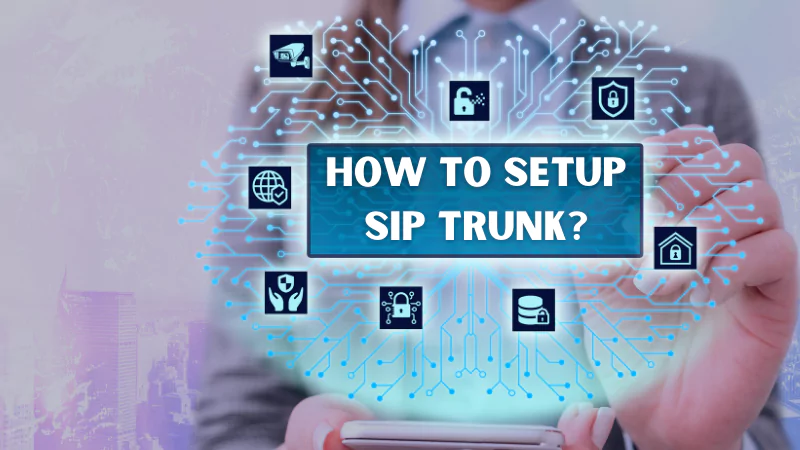Introduction
SIP trunking is a modern technology that allows businesses to make and receive phone calls over the internet, instead of relying on traditional phone lines. This technology can offer numerous benefits to businesses, including cost savings, improved scalability, and advanced features and functionality. However, implementing SIP trunking can be complex, requiring careful planning and execution. In this guide, we will provide an overview of SIP trunking setup and configuration, as well as best practices to help beginners successfully implement SIP trunking in their organization.
Getting Started with SIP Trunking
Before implementing SIP trunking, businesses should choose a SIP trunking provider that meets their needs in terms of pricing, reliability, features, and customer support. Some popular SIP trunking providers include Twilio, Vonage, and Nextiva. It’s also important to assess network readiness and ensure that the internet bandwidth and network infrastructure are compatible with SIP trunking. Finally, businesses will need to select a SIP-enabled PBX (Private Branch Exchange) to connect their IP phones to the SIP trunk.
Setting Up Your SIP Trunking
Once a SIP trunking provider, network readiness, and SIP-enabled PBX have been selected, businesses can begin setting up their SIP trunking. This typically involves configuring the PBX to work with the SIP trunking provider and setting up IP phones to work with the SIP trunk.
To configure the PBX, businesses will need to obtain SIP trunking credentials from their provider, such as a SIP username and password, SIP server hostname or IP address, and SIP port number. These credentials will need to be entered into the PBX configuration settings. The exact process for configuring the PBX will vary depending on the PBX software and SIP trunking provider used.
To set up IP phones, businesses will need to configure the phones to work with the SIP trunking provider and PBX. This typically involves entering the SIP server hostname or IP address, SIP username and password, and other configuration settings into the phone’s configuration menu. Again, the exact process will vary depending on the phone model and SIP trunking provider used.
Once the PBX and IP phones have been configured, it’s important to test the setup thoroughly to ensure that inbound and outbound calls are working correctly, as well as any additional features such as voicemail, call forwarding, and call waiting.
Network Security and SIP Trunking
Security is an important consideration when implementing SIP trunking. Businesses should configure their firewall and network security settings to allow SIP traffic to flow through, and implement security measures such as SIP encryption and authentication to protect against unauthorized access and eavesdropping.
Firewall configuration can be a complex process, and businesses may need to consult with their IT department or a network security professional to ensure that SIP traffic is allowed through the firewall without compromising network security.
SIP encryption and authentication are typically implemented through the use of TLS (Transport Layer Security) and SRTP (Secure Real-time Transport Protocol), which encrypt and authenticate SIP traffic respectively. These settings can be configured in the PBX and IP phones.
Monitoring and Optimizing SIP Trunking
Monitoring SIP trunking usage and performance is critical to identifying any issues or areas for improvement. Businesses should optimize their SIP trunking settings to ensure optimal quality and reliability, and make any necessary adjustments to network infrastructure or configuration settings.
Common SIP trunking performance metrics to monitor include call completion rates, call quality (measured in MOS or Mean Opinion Score), and network latency or delay. If these metrics fall below acceptable thresholds, businesses may need to make adjustments to their network infrastructure or SIP trunking settings.
SIP Trunking Best Practices
Implementing SIP trunking requires careful planning and execution. Here are some best practices to keep in mind:
-
- Choose a SIP trunking provider with a good reputation for reliability and customer support.
- Assess network readiness and ensure that the network infrastructure is compatible with SIP trunking.
- Select a SIP-enabled PBX that is compatible with the SIP trunking provider and IP phones.
- Configure the PBX and IP phones carefully and thoroughly, testing each component to ensure that inbound and outbound calls are working correctly.
- Implement network security measures such as firewall configuration, SIP encryption, and authentication to protect against unauthorized access and eavesdropping.
- Monitor SIP trunking performance and usage to identify any issues or areas for improvement, and optimize SIP trunking settings as necessary.
- Consider working with a network security professional or IT department to ensure optimal security and network performance.
Conclusion
SIP trunking can provide businesses with cost savings, improved scalability, and enhanced features and functionality. Implementing SIP trunking requires careful planning and execution, from choosing a reliable SIP trunking provider to configuring the PBX and IP phones, optimizing network security, and monitoring performance. By following best practices and working with experienced professionals, businesses can successfully implement SIP trunking and enjoy its benefits.





